Legislation of Equality and Diversity in Childcare: Roles and Benefits
VerifiedAdded on 2021/02/19
|6
|1441
|15
Report
AI Summary
This report examines the crucial aspects of equality, diversity, and inclusive practice within the realm of childcare. It begins by identifying key legislation, policies, and procedures, including the Equality Act 2010, Childcare Act 2006, Disability Discrimination Act 1995, and Special Education Needs and Disability Act 2001, all of which are designed to prevent discrimination and ensure equal treatment for all children. The report then elucidates the roles and responsibilities of early year practitioners, emphasizing the importance of implementing policies, engaging parents, eliminating discrimination, and fostering an inclusive environment. Furthermore, it highlights the benefits of a supportive practitioner, focusing on the ability to identify individual needs, promote fairness, and respect diverse cultures. The report concludes by reflecting on personal beliefs and values in practicing early year settings, underscoring the significance of treating all children equally, valuing their backgrounds, and promoting open communication to support their development. The report references several books and journals to support its findings.
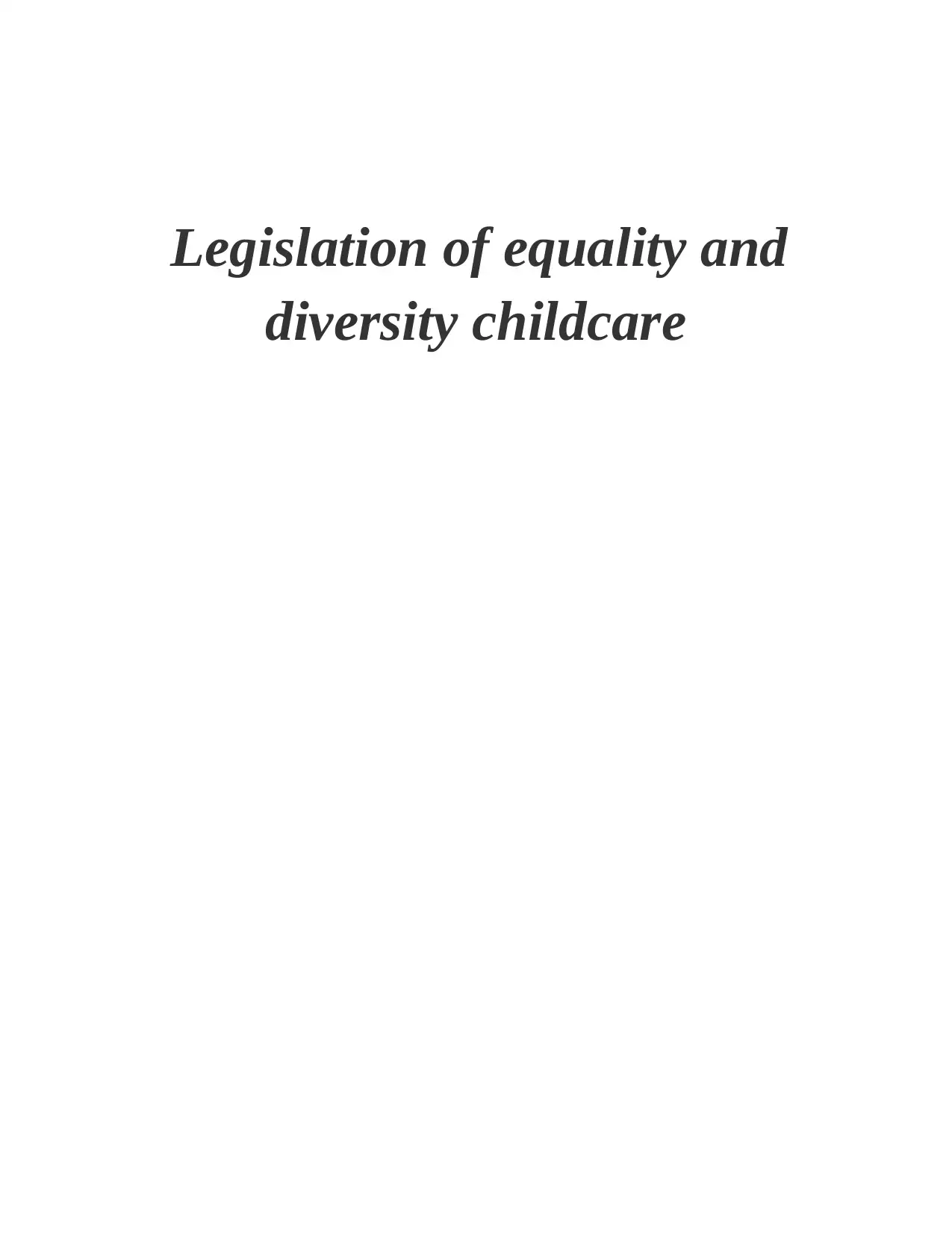
Legislation of equality and
diversity childcare
diversity childcare
Paraphrase This Document
Need a fresh take? Get an instant paraphrase of this document with our AI Paraphraser
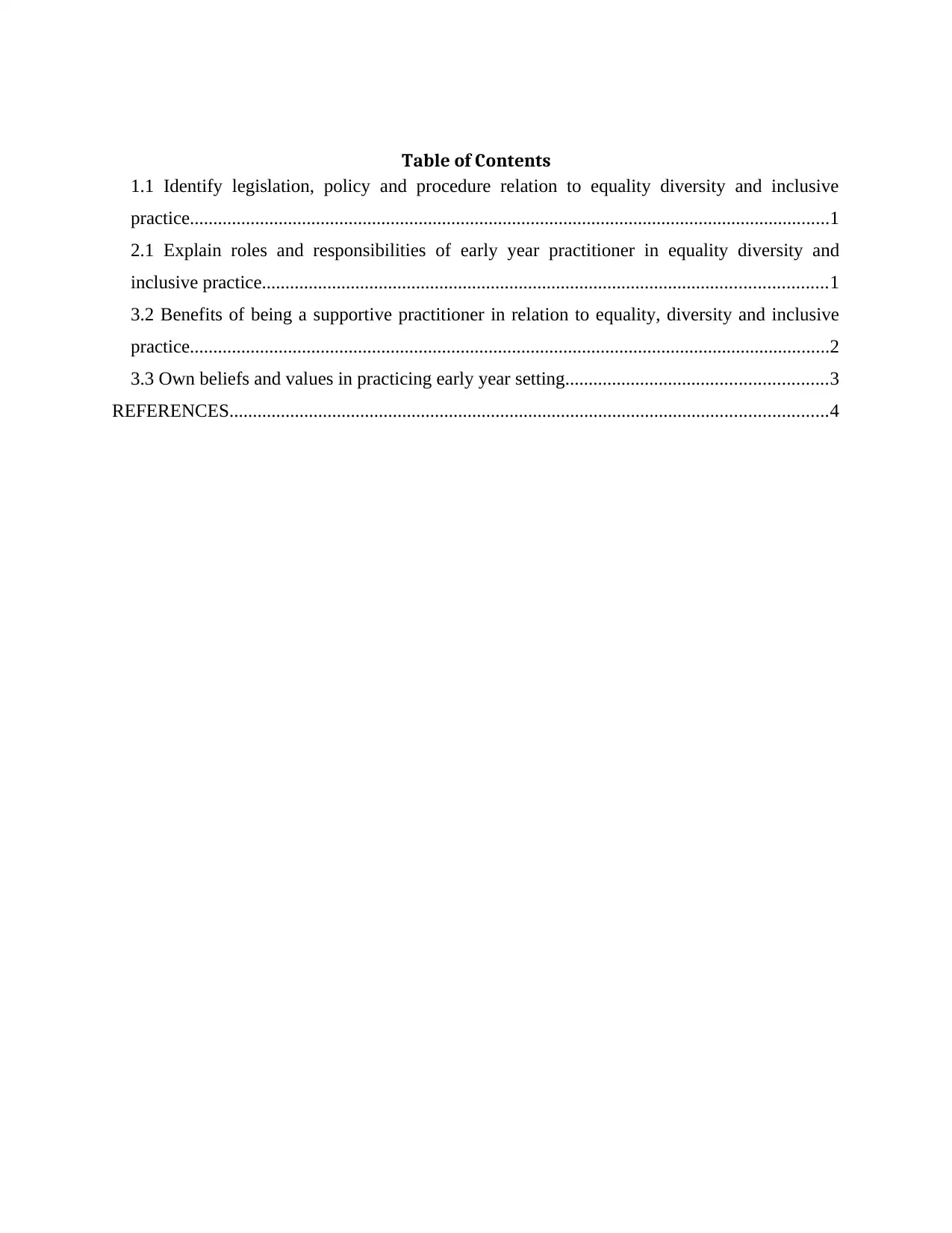
Table of Contents
1.1 Identify legislation, policy and procedure relation to equality diversity and inclusive
practice.........................................................................................................................................1
2.1 Explain roles and responsibilities of early year practitioner in equality diversity and
inclusive practice.........................................................................................................................1
3.2 Benefits of being a supportive practitioner in relation to equality, diversity and inclusive
practice.........................................................................................................................................2
3.3 Own beliefs and values in practicing early year setting........................................................3
REFERENCES................................................................................................................................4
1.1 Identify legislation, policy and procedure relation to equality diversity and inclusive
practice.........................................................................................................................................1
2.1 Explain roles and responsibilities of early year practitioner in equality diversity and
inclusive practice.........................................................................................................................1
3.2 Benefits of being a supportive practitioner in relation to equality, diversity and inclusive
practice.........................................................................................................................................2
3.3 Own beliefs and values in practicing early year setting........................................................3
REFERENCES................................................................................................................................4
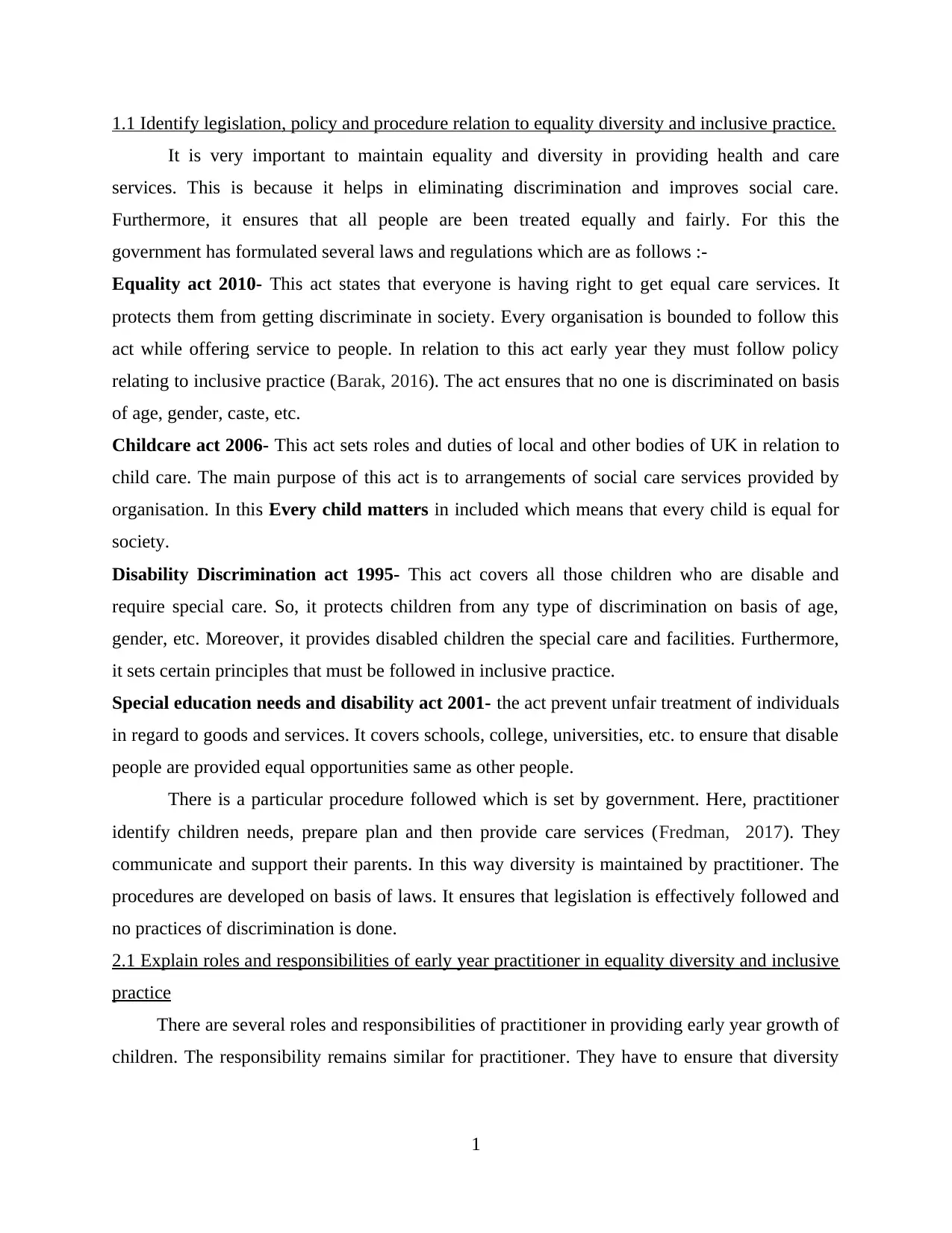
1.1 Identify legislation, policy and procedure relation to equality diversity and inclusive practice.
It is very important to maintain equality and diversity in providing health and care
services. This is because it helps in eliminating discrimination and improves social care.
Furthermore, it ensures that all people are been treated equally and fairly. For this the
government has formulated several laws and regulations which are as follows :-
Equality act 2010- This act states that everyone is having right to get equal care services. It
protects them from getting discriminate in society. Every organisation is bounded to follow this
act while offering service to people. In relation to this act early year they must follow policy
relating to inclusive practice (Barak, 2016). The act ensures that no one is discriminated on basis
of age, gender, caste, etc.
Childcare act 2006- This act sets roles and duties of local and other bodies of UK in relation to
child care. The main purpose of this act is to arrangements of social care services provided by
organisation. In this Every child matters in included which means that every child is equal for
society.
Disability Discrimination act 1995- This act covers all those children who are disable and
require special care. So, it protects children from any type of discrimination on basis of age,
gender, etc. Moreover, it provides disabled children the special care and facilities. Furthermore,
it sets certain principles that must be followed in inclusive practice.
Special education needs and disability act 2001- the act prevent unfair treatment of individuals
in regard to goods and services. It covers schools, college, universities, etc. to ensure that disable
people are provided equal opportunities same as other people.
There is a particular procedure followed which is set by government. Here, practitioner
identify children needs, prepare plan and then provide care services (Fredman, 2017). They
communicate and support their parents. In this way diversity is maintained by practitioner. The
procedures are developed on basis of laws. It ensures that legislation is effectively followed and
no practices of discrimination is done.
2.1 Explain roles and responsibilities of early year practitioner in equality diversity and inclusive
practice
There are several roles and responsibilities of practitioner in providing early year growth of
children. The responsibility remains similar for practitioner. They have to ensure that diversity
1
It is very important to maintain equality and diversity in providing health and care
services. This is because it helps in eliminating discrimination and improves social care.
Furthermore, it ensures that all people are been treated equally and fairly. For this the
government has formulated several laws and regulations which are as follows :-
Equality act 2010- This act states that everyone is having right to get equal care services. It
protects them from getting discriminate in society. Every organisation is bounded to follow this
act while offering service to people. In relation to this act early year they must follow policy
relating to inclusive practice (Barak, 2016). The act ensures that no one is discriminated on basis
of age, gender, caste, etc.
Childcare act 2006- This act sets roles and duties of local and other bodies of UK in relation to
child care. The main purpose of this act is to arrangements of social care services provided by
organisation. In this Every child matters in included which means that every child is equal for
society.
Disability Discrimination act 1995- This act covers all those children who are disable and
require special care. So, it protects children from any type of discrimination on basis of age,
gender, etc. Moreover, it provides disabled children the special care and facilities. Furthermore,
it sets certain principles that must be followed in inclusive practice.
Special education needs and disability act 2001- the act prevent unfair treatment of individuals
in regard to goods and services. It covers schools, college, universities, etc. to ensure that disable
people are provided equal opportunities same as other people.
There is a particular procedure followed which is set by government. Here, practitioner
identify children needs, prepare plan and then provide care services (Fredman, 2017). They
communicate and support their parents. In this way diversity is maintained by practitioner. The
procedures are developed on basis of laws. It ensures that legislation is effectively followed and
no practices of discrimination is done.
2.1 Explain roles and responsibilities of early year practitioner in equality diversity and inclusive
practice
There are several roles and responsibilities of practitioner in providing early year growth of
children. The responsibility remains similar for practitioner. They have to ensure that diversity
1
⊘ This is a preview!⊘
Do you want full access?
Subscribe today to unlock all pages.

Trusted by 1+ million students worldwide
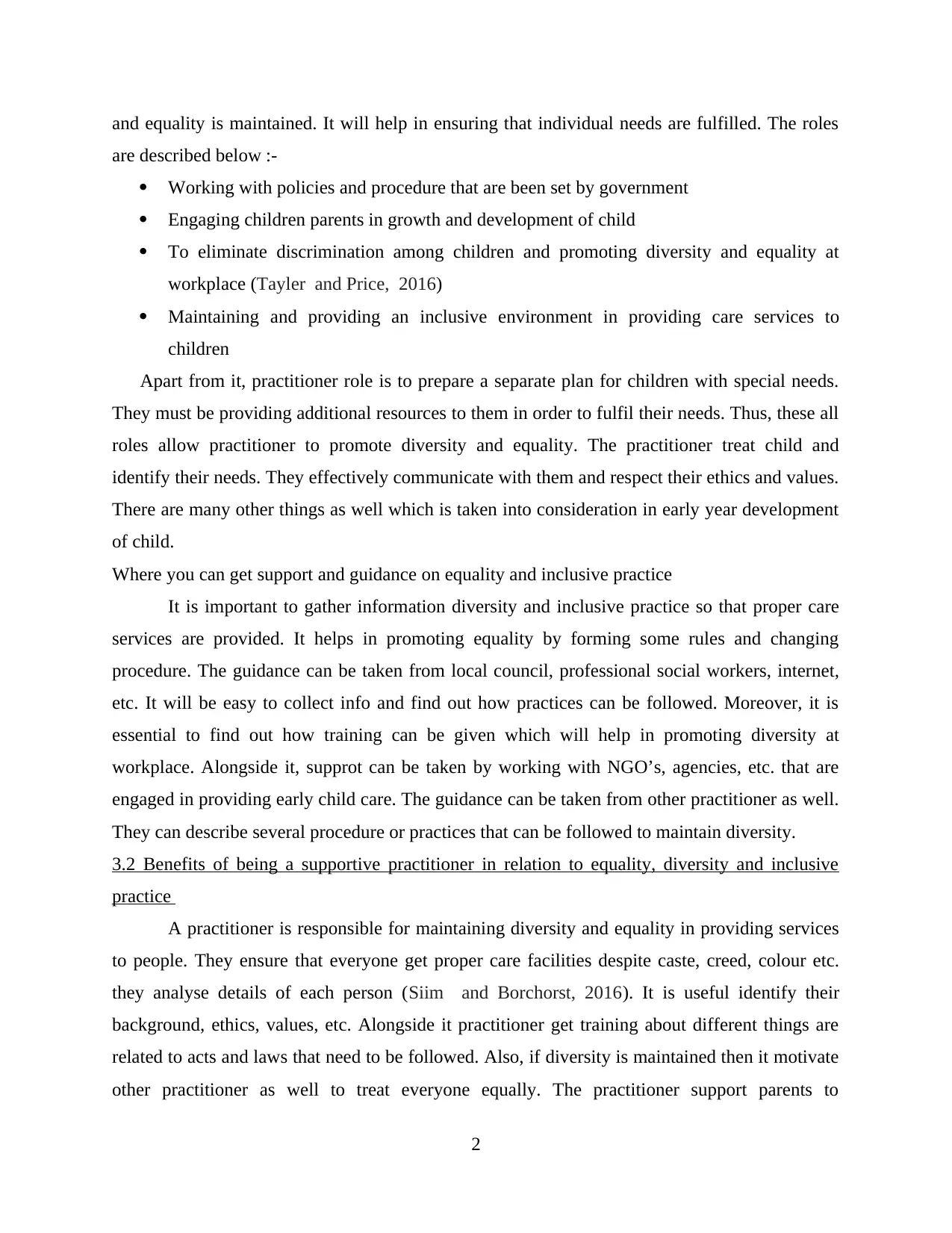
and equality is maintained. It will help in ensuring that individual needs are fulfilled. The roles
are described below :-
Working with policies and procedure that are been set by government
Engaging children parents in growth and development of child
To eliminate discrimination among children and promoting diversity and equality at
workplace (Tayler and Price, 2016)
Maintaining and providing an inclusive environment in providing care services to
children
Apart from it, practitioner role is to prepare a separate plan for children with special needs.
They must be providing additional resources to them in order to fulfil their needs. Thus, these all
roles allow practitioner to promote diversity and equality. The practitioner treat child and
identify their needs. They effectively communicate with them and respect their ethics and values.
There are many other things as well which is taken into consideration in early year development
of child.
Where you can get support and guidance on equality and inclusive practice
It is important to gather information diversity and inclusive practice so that proper care
services are provided. It helps in promoting equality by forming some rules and changing
procedure. The guidance can be taken from local council, professional social workers, internet,
etc. It will be easy to collect info and find out how practices can be followed. Moreover, it is
essential to find out how training can be given which will help in promoting diversity at
workplace. Alongside it, supprot can be taken by working with NGO’s, agencies, etc. that are
engaged in providing early child care. The guidance can be taken from other practitioner as well.
They can describe several procedure or practices that can be followed to maintain diversity.
3.2 Benefits of being a supportive practitioner in relation to equality, diversity and inclusive
practice
A practitioner is responsible for maintaining diversity and equality in providing services
to people. They ensure that everyone get proper care facilities despite caste, creed, colour etc.
they analyse details of each person (Siim and Borchorst, 2016). It is useful identify their
background, ethics, values, etc. Alongside it practitioner get training about different things are
related to acts and laws that need to be followed. Also, if diversity is maintained then it motivate
other practitioner as well to treat everyone equally. The practitioner support parents to
2
are described below :-
Working with policies and procedure that are been set by government
Engaging children parents in growth and development of child
To eliminate discrimination among children and promoting diversity and equality at
workplace (Tayler and Price, 2016)
Maintaining and providing an inclusive environment in providing care services to
children
Apart from it, practitioner role is to prepare a separate plan for children with special needs.
They must be providing additional resources to them in order to fulfil their needs. Thus, these all
roles allow practitioner to promote diversity and equality. The practitioner treat child and
identify their needs. They effectively communicate with them and respect their ethics and values.
There are many other things as well which is taken into consideration in early year development
of child.
Where you can get support and guidance on equality and inclusive practice
It is important to gather information diversity and inclusive practice so that proper care
services are provided. It helps in promoting equality by forming some rules and changing
procedure. The guidance can be taken from local council, professional social workers, internet,
etc. It will be easy to collect info and find out how practices can be followed. Moreover, it is
essential to find out how training can be given which will help in promoting diversity at
workplace. Alongside it, supprot can be taken by working with NGO’s, agencies, etc. that are
engaged in providing early child care. The guidance can be taken from other practitioner as well.
They can describe several procedure or practices that can be followed to maintain diversity.
3.2 Benefits of being a supportive practitioner in relation to equality, diversity and inclusive
practice
A practitioner is responsible for maintaining diversity and equality in providing services
to people. They ensure that everyone get proper care facilities despite caste, creed, colour etc.
they analyse details of each person (Siim and Borchorst, 2016). It is useful identify their
background, ethics, values, etc. Alongside it practitioner get training about different things are
related to acts and laws that need to be followed. Also, if diversity is maintained then it motivate
other practitioner as well to treat everyone equally. The practitioner support parents to
2
Paraphrase This Document
Need a fresh take? Get an instant paraphrase of this document with our AI Paraphraser
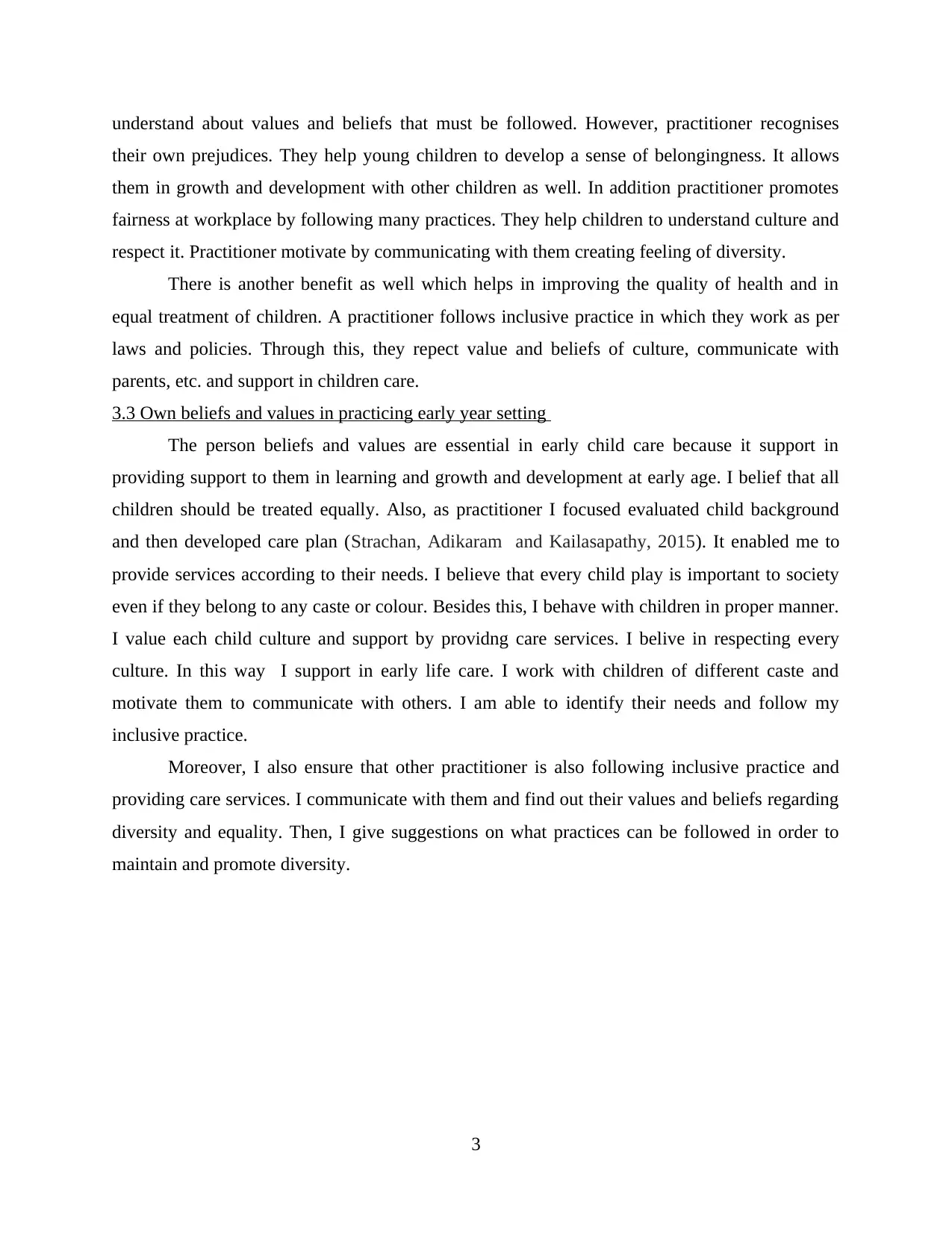
understand about values and beliefs that must be followed. However, practitioner recognises
their own prejudices. They help young children to develop a sense of belongingness. It allows
them in growth and development with other children as well. In addition practitioner promotes
fairness at workplace by following many practices. They help children to understand culture and
respect it. Practitioner motivate by communicating with them creating feeling of diversity.
There is another benefit as well which helps in improving the quality of health and in
equal treatment of children. A practitioner follows inclusive practice in which they work as per
laws and policies. Through this, they repect value and beliefs of culture, communicate with
parents, etc. and support in children care.
3.3 Own beliefs and values in practicing early year setting
The person beliefs and values are essential in early child care because it support in
providing support to them in learning and growth and development at early age. I belief that all
children should be treated equally. Also, as practitioner I focused evaluated child background
and then developed care plan (Strachan, Adikaram and Kailasapathy, 2015). It enabled me to
provide services according to their needs. I believe that every child play is important to society
even if they belong to any caste or colour. Besides this, I behave with children in proper manner.
I value each child culture and support by providng care services. I belive in respecting every
culture. In this way I support in early life care. I work with children of different caste and
motivate them to communicate with others. I am able to identify their needs and follow my
inclusive practice.
Moreover, I also ensure that other practitioner is also following inclusive practice and
providing care services. I communicate with them and find out their values and beliefs regarding
diversity and equality. Then, I give suggestions on what practices can be followed in order to
maintain and promote diversity.
3
their own prejudices. They help young children to develop a sense of belongingness. It allows
them in growth and development with other children as well. In addition practitioner promotes
fairness at workplace by following many practices. They help children to understand culture and
respect it. Practitioner motivate by communicating with them creating feeling of diversity.
There is another benefit as well which helps in improving the quality of health and in
equal treatment of children. A practitioner follows inclusive practice in which they work as per
laws and policies. Through this, they repect value and beliefs of culture, communicate with
parents, etc. and support in children care.
3.3 Own beliefs and values in practicing early year setting
The person beliefs and values are essential in early child care because it support in
providing support to them in learning and growth and development at early age. I belief that all
children should be treated equally. Also, as practitioner I focused evaluated child background
and then developed care plan (Strachan, Adikaram and Kailasapathy, 2015). It enabled me to
provide services according to their needs. I believe that every child play is important to society
even if they belong to any caste or colour. Besides this, I behave with children in proper manner.
I value each child culture and support by providng care services. I belive in respecting every
culture. In this way I support in early life care. I work with children of different caste and
motivate them to communicate with others. I am able to identify their needs and follow my
inclusive practice.
Moreover, I also ensure that other practitioner is also following inclusive practice and
providing care services. I communicate with them and find out their values and beliefs regarding
diversity and equality. Then, I give suggestions on what practices can be followed in order to
maintain and promote diversity.
3
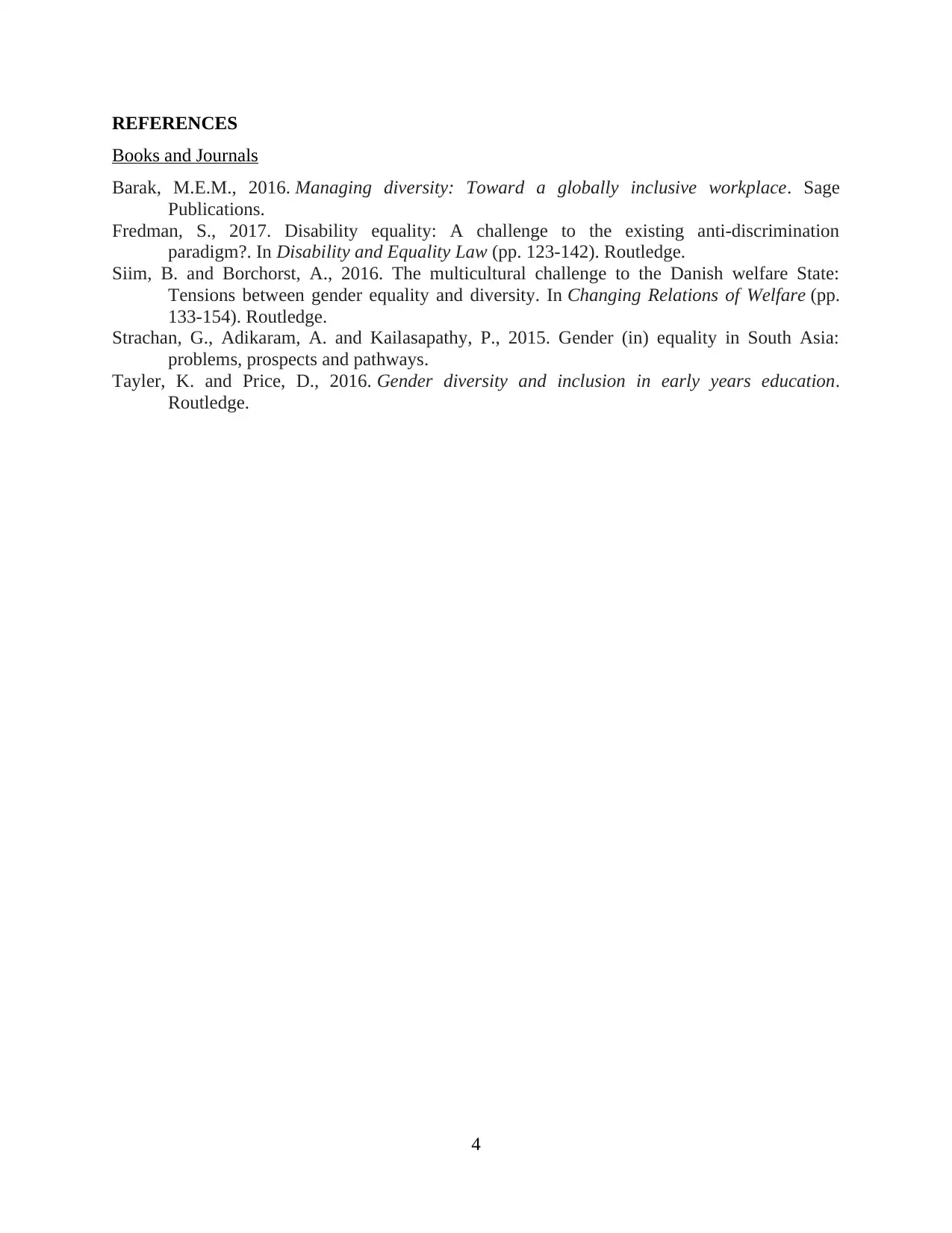
REFERENCES
Books and Journals
Barak, M.E.M., 2016. Managing diversity: Toward a globally inclusive workplace. Sage
Publications.
Fredman, S., 2017. Disability equality: A challenge to the existing anti-discrimination
paradigm?. In Disability and Equality Law (pp. 123-142). Routledge.
Siim, B. and Borchorst, A., 2016. The multicultural challenge to the Danish welfare State:
Tensions between gender equality and diversity. In Changing Relations of Welfare (pp.
133-154). Routledge.
Strachan, G., Adikaram, A. and Kailasapathy, P., 2015. Gender (in) equality in South Asia:
problems, prospects and pathways.
Tayler, K. and Price, D., 2016. Gender diversity and inclusion in early years education.
Routledge.
4
Books and Journals
Barak, M.E.M., 2016. Managing diversity: Toward a globally inclusive workplace. Sage
Publications.
Fredman, S., 2017. Disability equality: A challenge to the existing anti-discrimination
paradigm?. In Disability and Equality Law (pp. 123-142). Routledge.
Siim, B. and Borchorst, A., 2016. The multicultural challenge to the Danish welfare State:
Tensions between gender equality and diversity. In Changing Relations of Welfare (pp.
133-154). Routledge.
Strachan, G., Adikaram, A. and Kailasapathy, P., 2015. Gender (in) equality in South Asia:
problems, prospects and pathways.
Tayler, K. and Price, D., 2016. Gender diversity and inclusion in early years education.
Routledge.
4
⊘ This is a preview!⊘
Do you want full access?
Subscribe today to unlock all pages.

Trusted by 1+ million students worldwide
1 out of 6
Related Documents
Your All-in-One AI-Powered Toolkit for Academic Success.
+13062052269
info@desklib.com
Available 24*7 on WhatsApp / Email
![[object Object]](/_next/static/media/star-bottom.7253800d.svg)
Unlock your academic potential
Copyright © 2020–2025 A2Z Services. All Rights Reserved. Developed and managed by ZUCOL.





